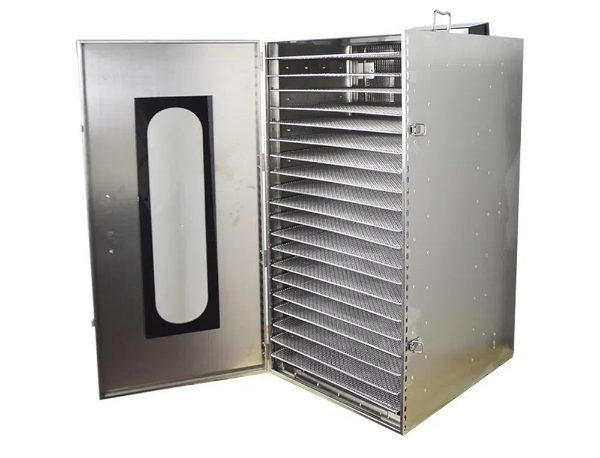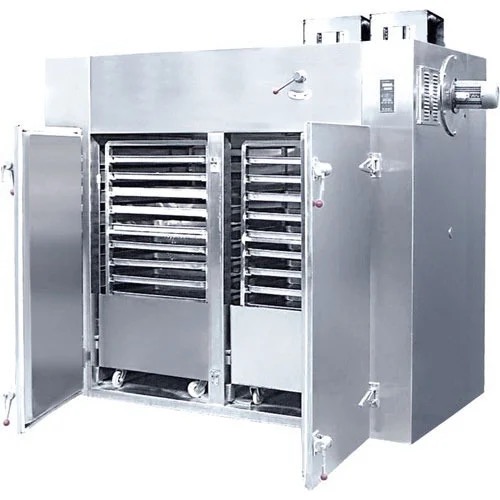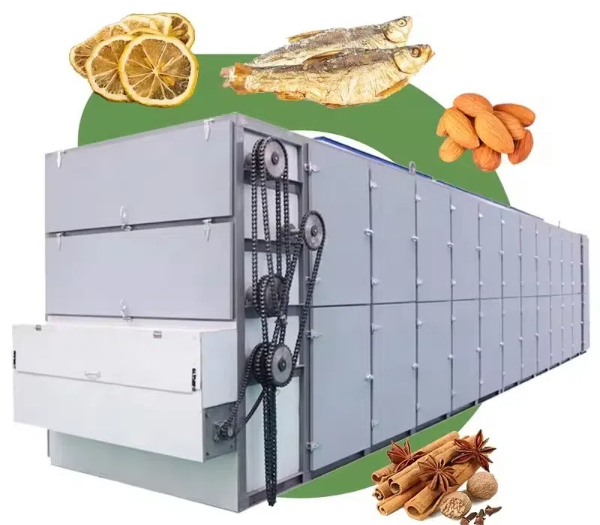
Content Menu
● The Critical Role of Efficiency in Modern Food Drying
>> Energy Cost Dynamics in Drying Operations
>> Quality Preservation Mechanisms
● Technical Deep Dive: Dryer Types & Applications
>> 1. Multi-Layer Conveyor Dryers
>> 2. Heat Pump-Assisted Dryers
>> 3. Fluidized Bed Dryers
>> Emerging Solutions
● Engineering Considerations for OEM Selection
>> Core Performance Parameters
>> Customization Options for OEM Partners
● Operational Excellence: Maximizing Dryer Efficiency
>> Preventive Maintenance Checklist
>> Advanced Process Controls
● Global Compliance Landscape
● The ROI Equation: Cost vs. Long-Term Savings
● Future Trends Shaping Drying Technology
● Conclusion: Strategic Investment for Competitive Advantage
● FAQ
>> 1. How do modern dryers prevent nutrient loss compared to traditional methods?
>> 2. What's the typical payback period for upgrading to energy-efficient dryers?
>> 3. How does OEM customization enhance drying efficiency?
>> 4. Can existing dryers be retrofitted for better efficiency?
>> 5. What maintenance practices maximize dryer lifespan?
● Citations:
In the competitive landscape of food processing, efficiency in drying operations isn't optional—it's a strategic imperative. As global demand for preserved foods grows and sustainability standards tighten, selecting optimal drying equipment becomes pivotal for maintaining profitability and market relevance.

The Critical Role of Efficiency in Modern Food Drying
Energy Cost Dynamics in Drying Operations
Thermal drying processes account for 12-20% of total industrial energy consumption in developed nations according to the International Energy Agency. For food processors, drying typically represents 35-45% of total production energy costs. High-efficiency dryers can slash these figures by:
- 40-50% reduction in thermal energy requirements
- 30% decrease in electricity consumption
- 15-20% shorter processing times
| Traditional Dryer | High-Efficiency Dryer |
|
| Energy Cost/Ton | $28-$35 | $16-$22 |
| Drying Time (hrs) | 8-10 | 5-7 |
| CO2 Emissions | 120 kg | 68 kg |
Quality Preservation Mechanisms
Modern drying systems maintain product integrity through:
1. Precision Humidity Control (±1.5% RH accuracy)
2. Gradual Temperature Ramping (prevents case hardening)
3. AI-powered Moisture Monitoring (real-time adjustments)
A 2024 study in *Journal of Food Engineering* showed that advanced dryers preserve:
- 92% of vitamin C in fruits vs. 74% in conventional systems
- 88% anthocyanin content in berries vs. 63% previously
Technical Deep Dive: Dryer Types & Applications
1. Multi-Layer Conveyor Dryers
Optimal For: Herbs, vegetables, sliced fruits
Key Features:
- 3-5 tier stainless steel mesh belts
- Counterflow air configuration
- 50-90°C operating range
- Capacity: 200-2,000 kg/hr
2. Heat Pump-Assisted Dryers
Ideal Applications: Seafood, jerky, tropical fruits
Performance Metrics:
- COP (Coefficient of Performance): 3.8-4.2
- Moisture Extraction Rate: 4-6 L/hr
- Temperature Stability: ±0.5°C
Case Example: Thai coconut processor achieved 53% energy savings switching from gas-fired to heat pump dryers.
3. Fluidized Bed Dryers
Best For: Granular products (grains, coffee beans)
Technical Advantages:
- 25% faster drying vs. static beds
- Integrated cyclone separators
- GMP-compliant designs available
Emerging Solutions
- Microwave-Vacuum Hybrids: Combines rapid internal heating (microwave) with low-temperature operation (vacuum)
- IR+Hot Air Combos: Infrared pre-drying reduces total moisture load
- Solar-Assisted Systems: 30-40% renewable energy integration

Engineering Considerations for OEM Selection
Core Performance Parameters
1. Specific Moisture Evaporation Rate (SMER)
- Target: >1.5 kg water/kWh
2. Thermal Efficiency
- Minimum 65% for convective systems
3. Airflow Uniformity
- <10% variation across drying zones
Customization Options for OEM Partners
- Material compatibility (stainless steel grades)
- CIP (Clean-in-Place) configurations
- Explosion-proof designs for powder handling
- Multi-fuel capabilities (gas/electric/steam)
Operational Excellence: Maximizing Dryer Efficiency
Preventive Maintenance Checklist
| Component | Maintenance Interval | Key Actions |
| Heat Exchangers | 500 hrs | Fins cleaning, pressure testing |
| Belt Systems | 250 hrs | Tension adjustment, wear inspection |
| Sensors | 1,000 hrs | Calibration checks |
Advanced Process Controls
- Model Predictive Control (MPC) algorithms
- Wireless IoT moisture sensors
- Digital twin simulations for parameter optimization
Global Compliance Landscape
Essential Certifications for Export-Oriented Equipment:
1. CE Marking (EU Machinery Directive)
2. NSF/ANSI 4 (Food Equipment Standards)
3. ATEX Directive (Explosive Atmospheres)
4. Energy Star (Energy Efficiency Compliance)
The ROI Equation: Cost vs. Long-Term Savings
| Basic Dryer | Advanced Dryer |
|
| Initial Cost | $85,000 | $150,000 |
| Annual Energy Cost | $42,000 | $23,000 |
| Maintenance | $8,000 | $5,500 |
| 5-Year TCO | $323,000 | $234,500 |
Future Trends Shaping Drying Technology
1. Artificial Intelligence Integration
- Self-optimizing drying curves based on raw material analytics
- Predictive maintenance algorithms
2. Decentralized Renewable Integration
- On-site solar thermal storage systems
- Biofuel-compatible burners
3. Water Recovery Systems
- Closed-loop condensate treatment
- 85% water reuse potential
Conclusion: Strategic Investment for Competitive Advantage
Choosing efficient drying equipment transcends mere technical selection—it's a fundamental business strategy. The right OEM partner should deliver:
- Technical Expertise: Deep understanding of food-specific drying dynamics
- Custom Engineering: Tailored solutions for unique product lines
- Lifecycle Support: From installation to spare parts management
As global food safety standards (BRCGS, IFS) increasingly incorporate energy efficiency metrics, early adopters of advanced drying technologies will gain significant market advantages. The future belongs to processors who view drying efficiency not as a cost center, but as a value-creation engine.

FAQ
1. How do modern dryers prevent nutrient loss compared to traditional methods?
Advanced dryers use multi-stage drying profiles that adjust temperature and humidity dynamically. For example, initial high-humidity phases preserve heat-sensitive nutrients, followed by controlled dehydration stages. Real-time NIR sensors monitor nutrient levels, automatically adjusting parameters to optimize retention.
2. What's the typical payback period for upgrading to energy-efficient dryers?
Most food processors see ROI within 18-30 months through:
- 40-60% lower energy bills
- 15-25% increased throughput
- 30-50% reduced waste
Government incentives for green manufacturing can shorten payback by 6-8 months.
3. How does OEM customization enhance drying efficiency?
Tailored solutions address specific needs like:
- Specialized air distribution for irregularly shaped products
- Corrosion-resistant materials for high-acidity foods
- Modular designs allowing future capacity expansions
Customization typically improves overall efficiency by 12-18% versus generic models.
4. Can existing dryers be retrofitted for better efficiency?
Yes, common retrofits include:
- Installing heat recovery ventilators (25-35% energy savings)
- Upgrading to VFD-controlled fans (18-22% electricity reduction)
- Adding smart sensors for process optimization (10-15% yield improvement)
5. What maintenance practices maximize dryer lifespan?
Critical protocols include:
- Quarterly belt tension checks
- Semi-annual heat exchanger descaling
- Annual electrical system inspections
- Real-time bearing condition monitoring
Proactive maintenance can extend equipment life by 40-60%.
Citations:
[1] https://carriervibrating.com/resources/blog/save-money-drying-process/
[2] https://www.dryeratech.com/why-energy-efficiency-matters-in-industrial-hanging-systems.html
[3] https://etsolutions.in/10-amazing-benefits-of-electrical-food-dehydrator-machines/
[4] https://www.iqsdirectory.com/articles/dryer/types-of-dryers.html
[5] https://food-drying-machine.com
[6] https://www.istockphoto.com/photos/food-dehydrator
[7] https://www.ike.cn/video.html
[8] https://www.youtube.com/watch?v=qtC36z0HleQ
[9] https://carriervibrating.com/resources/blog/achieving-optimal-drying-results-for-pressed-fruits-and-vegetables/
[10] https://www.dryequipmfr.com/oem-electric-food-dehydrator-factory/
[11] https://www.dreamstime.com/photos-images/food-dehydrator.html
[12] https://www.youtube.com/watch?v=Ny6tGbu2nQ0
[13] https://www.youtube.com/watch?v=mtDzdYoyeR8
[14] https://www.dehydratorsamerica.com/category/shop-all
[15] https://www.foodengineeringmag.com/articles/96863-energy-efficiency-controls-offer-processors-better-drying-options
[16] https://www.bestbuy.com/discover-learn/10-reasons-to-buy-a-food-dehydrator/pcmcat1634332391134
[17] https://palinox.com/en/technology-and-efficiency-in-drying-systems/
[18] https://www.nizo.com/blog/3-factors-which-decrease-processing-efficiency/
[19] https://www.cpeg.com/blog/comparing-industrial-drying-equipment/
[20] https://gcwgandhinagar.com/econtent/document/1588156026Unit%20V%20Types%20of%20dryers%20and%20their%20applications.pdf
[21] https://www.seriouseats.com/best-food-dehydrators-5216308
[22] https://bluealpinefreezedryers.com/collections/freeze-dryers
[23] https://www.fsdalle.com/fruit-dryer-dehydrator-drying-machine/
[24] https://www.dryequipmfr.com/vegetable-and-fruit-dryer-machine/
[25] https://www.fsdalle.com/custom-dehydrator-machine-48-tray/
[26] https://www.youtube.com/watch?v=8XID-nxU5K0
[27] https://www.istockphoto.com/photos/food-dryer
[28] https://www.youtube.com/watch?v=Namf-Ddo_Xo
[29] https://www.shutterstock.com/search/dehydrator-machine
[30] https://www.youtube.com/watch?v=1fP2rSLjys4
[31] https://www.shutterstock.com/video/search/electric-food-dehydrator
[32] https://onecpm.com/success-story/efficiency-flexibility-growth-snack-food-manufacturers-choose-triple-pass-dryer
[33] https://airtekdehydrator.com/blog/benefits-of-a-fruits-drying-machine/
[34] https://www.powderbulksolids.com/drying/increasing-drying-efficiency
[35] https://ancoeas.com/news/maximizing-efficiency-in-feather-meal-processing/
[36] https://trueprepper.com/best-freeze-dryer/
[37] https://airtekdehydrator.com/blog/types-commercial-food-dehydrators/
[38] https://www.thespruceeats.com/best-food-dehydrators-4077285
[39] https://apps.dtic.mil/sti/tr/pdf/ADA290816.pdf
[40] https://kerone.com/blog/drying-of-food/
[41] https://www.foodnetwork.com/how-to/packages/shopping/product-reviews/best-food-dehydrators
[42] https://www.made-in-china.com/manufacturers/best-food-dehydrator.html
[43] https://us.metoree.com/categories/7583/
[44] https://www.ensightsolutions.us/oem_sanitation_responsibilities/
[45] https://industrialdryers.com/food-dryers/
[46] https://www.bepex.com/processes/drying
[47] https://www.youtube.com/watch?v=Fhv8Lf5L8Iw











